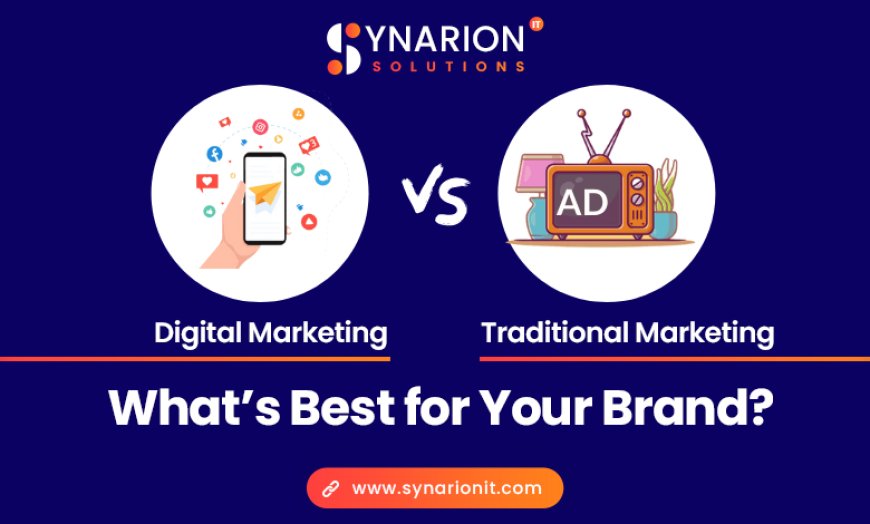Digital Marketing vs Traditional Marketing: What’s Best for Your Brand?

In today’s fast-evolving business landscape, marketing strategies have taken on new dimensions. The debate between digital marketing and traditional marketing is more relevant than ever for brands looking to make a significant impact. Choosing the right marketing approach can determine the success or failure of a campaign, influencing brand visibility, customer engagement, and ultimately, sales. So, what exactly sets these two marketing paradigms apart, and which one is best suited for your brand?
Understanding Digital Marketing
Digital marketing refers to the promotion of products or services using digital channels, primarily on the internet. This includes methods such as social media marketing, search engine optimization (SEO), email marketing, pay-per-click advertising (PPC), content marketing, influencer collaborations, and more. The rise of smartphones and widespread internet access has accelerated the adoption of digital marketing, making it a critical tool for brands globally.
Businesses today frequently collaborate with a digital marketing company in India to leverage cost-effective, innovative, and scalable marketing solutions. India’s digital marketing firms are known for their expertise in SEO, data analytics, social media strategies, and creative campaigns tailored to diverse markets, helping brands reach their target audience efficiently.
Understanding Traditional Marketing
Traditional marketing, on the other hand, refers to conventional methods such as print advertisements (newspapers, magazines), broadcast media (TV, radio), outdoor advertising (billboards, flyers), direct mail, and telemarketing. This form of marketing has been the cornerstone of brand promotion for decades, and it remains relevant in many industries and demographics.
Traditional marketing tends to focus on broad reach through physical and local media, targeting audiences who may not be as digitally connected. It offers tangible materials that consumers can hold, such as brochures and flyers, which can create a lasting impression.
Key Differences Between Digital Marketing and Traditional Marketing
Reach and Targeting
Digital marketing excels in precise targeting. Brands can segment their audience by demographics, interests, behavior, location, and more, ensuring marketing messages reach the most relevant users. This level of granularity is difficult to achieve with traditional marketing, which often relies on broad audience groups and geographic regions.
Cost-Effectiveness
For many brands, digital marketing presents a more affordable alternative. Running an online ad campaign, optimizing content for search engines, or engaging with customers on social media can often be done at a fraction of the cost of TV commercials or print ads. This affordability is why startups and small businesses often seek a digital marketing company in India, as they offer competitive pricing along with expert services.
Measurement and Analytics
One of the greatest advantages of digital marketing is the ability to measure performance in real-time. Marketers can track click-through rates, conversions, bounce rates, and customer engagement instantly, allowing for quick adjustments to strategies. Traditional marketing, by contrast, has less precise metrics — gauging impact often relies on estimates or delayed feedback.
Engagement and Interaction
Digital marketing fosters two-way communication, allowing brands to engage directly with their audience through comments, messages, reviews, and shares. This interaction helps build relationships and trust. Traditional marketing is more one-sided, delivering messages without immediate audience feedback.
Longevity and Visibility
Traditional marketing materials like billboards and print ads may have a longer physical presence, but their visibility is limited in duration and scope. Digital content can remain accessible online indefinitely and can be shared across platforms, expanding a brand’s reach over time.
Which Marketing Strategy Is Best for Your Brand?
Choosing between digital and traditional marketing depends on several factors including your brand’s goals, target audience, budget, and industry.
When Digital Marketing Is Ideal
- Targeting Younger Audiences: If your brand caters to millennials or Gen Z, digital marketing is indispensable. These groups spend significant time online and respond well to social media campaigns, influencer marketing, and engaging content.
- Budget Constraints: For brands with limited marketing budgets, digital marketing provides scalable options where you can start small and increase investment based on ROI.
- Data-Driven Decisions: If your brand values analytics and precise measurement to optimize campaigns, digital marketing’s transparency offers a clear advantage.
- Global Reach: For companies looking to expand internationally, digital marketing offers an easy way to reach global audiences without the geographic limitations of traditional marketing.
When Traditional Marketing Can Work Better
- Local or Regional Campaigns: Traditional marketing can effectively target local audiences through billboards, local newspapers, radio, and events.
- Older Demographics: If your audience consists primarily of older individuals who may not be as digitally active, traditional media remains a trustworthy channel.
- Brand Awareness: For some brands, mass media campaigns on TV or print can boost brand awareness quickly across large populations.
- Tangible Impact: Certain products or services benefit from tangible marketing materials like brochures or in-store displays, which traditional marketing offers.
Combining Both for Maximum Impact
Rather than choosing one over the other, many successful brands adopt an integrated marketing approach. This means combining the strengths of digital marketing and traditional marketing to create cohesive, multi-channel campaigns. For example, a brand can use TV ads to build broad awareness and then retarget interested viewers online through digital ads or email campaigns.
Brands that partner with a reputed digital marketing company in India often benefit from this hybrid strategy. Indian agencies frequently offer end-to-end marketing services, blending offline and online efforts to maximize brand exposure and engagement.
Conclusion
Both digital marketing and traditional marketing have distinct advantages and can contribute significantly to a brand’s success. Digital marketing offers precision, cost-efficiency, and engagement, making it essential in the modern business environment. Meanwhile, traditional marketing still holds value for its broad reach and tangible presence.
For brands aiming to thrive in today’s competitive landscape, the best approach often involves a strategic mix tailored to their unique audience and goals. Engaging with a professional digital marketing company in India can provide the expertise needed to navigate this dynamic field, ensuring your brand leverages the right channels to achieve optimal results.
Ultimately, understanding your brand’s target customers and marketing objectives will guide the best choice between digital marketing, traditional marketing, or a powerful combination of both.























































































































































